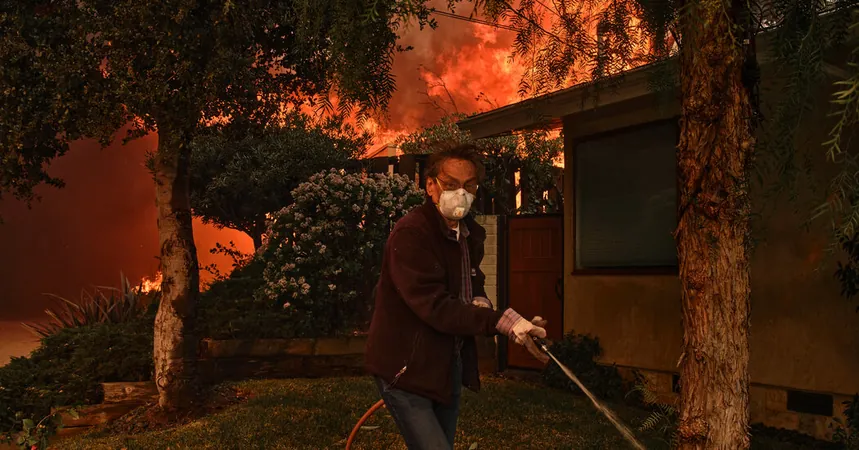
California Wildfires: A Tipping Point for the Insurance Industry?
2025-01-08
Author: Chun
The ongoing wildfires in Los Angeles are putting more than just homes at risk — they could potentially cause losses nearing $10 billion, according to preliminary estimates from J.P. Morgan. With over 13,000 properties in jeopardy, the aftershocks of this catastrophe could fundamentally shake an insurance market already on shaky ground.
Impact on Affluent and High-Risk Areas
The Palisades fire is not just impacting affluent neighborhoods, where the average home price hovers around $3.5 million, but also areas perilously situated in wildfire-prone zones. Homes built into the hillside offer breathtaking views of the Pacific Ocean but also make residents vulnerable to the fierce Santa Ana winds that can carry flames from one structure to another, igniting a chain reaction that could lead to widespread devastation.
Concerns from Experts
Michael Wara, director of the climate and energy policy program at Stanford's Woods Institute for the Environment, expressed grave concern: “You have uncontrolled fire spread — you could lose $30 billion overnight.” This disaster unfolds at a particularly tumultuous time for California, which has been enduring a severe homeowners insurance crisis. The state had already implemented new regulations at the end of last year aimed at stabilizing the beleaguered insurance market, but these protective measures may come too late to avert a fiscal crisis.
Insurance Market Adjustments
The latest changes permit insurers to incorporate catastrophic risks into their policies more comprehensively, allowing them to pass increased costs onto homeowners. These adjustments follow a trend that saw major insurers significantly retreating from the market after major wildfires in 2017 and 2018, which collectively inflicted about $23 billion in damage. In those years, the insurance industry suffered immense losses, paying out more than double the premiums received.
Shifts in the Insurance Landscape
In a sign of shifting dynamics, Allstate has hinted at re-entering the California market after freezing new policies in 2022, while State Farm, the state's leading home insurer, has requested substantial rate hikes for 2024. In Los Angeles, the average annual homeowners insurance policy costs about $1,583 — higher than most other California locales but still below the national average. In contrast, Pacific Palisades homeowners bear an average premium of $7,520, as highlighted in a recent analysis by the San Francisco Chronicle.
Challenges for Homeowners
The reality is dire for many homeowners struggling to secure insurance coverage. Last summer, around 70 percent of State Farm's clients in Pacific Palisades — roughly 1,600 households — lost their policies when the company retreated from high-risk areas. An alarming analysis found that over 100,000 Californians have experienced loss of coverage between 2019 and 2024. Prominent actor James Woods, who was forced to evacuate his Pacific Palisades residence, lamented on social media how a major insurer had canceled all local policies a few months prior.
The California FAIR Plan
In the wake of these challenges, many homeowners have turned to the California FAIR Plan, a last-resort insurance pool designed for high-risk properties. Coverage under this plan caps at $3 million for residential properties and $20 million for commercial ones. Since late 2020, the FAIR plan has seen a staggering 123 percent increase in policies, totaling around 452,000 as of September 2024.
Concerns Over Future Insurance Crises
However, the FAIR Plan's exposure in Pacific Palisades alone stands at $5.9 billion, and state regulations allow it to seek emergency funding from private insurers if claims exceed its reserves — a mechanism that raises concerns given the current reticence of private insurers to operate in California. If wildfires produce losses comparable to those of 2018 or 2019, California may be headed for an unprecedented insurance crisis.
Conclusion
As the flames rage on, experts warn that the current situation serves as a litmus test for California's insurance system and its ability to withstand a barrage of natural disasters. Will the legislation be enough to safeguard homeowners and stabilize the insurance landscape, or is a catastrophe looming on the horizon? Stay tuned, as this story continues to unfold.


 Brasil (PT)
Brasil (PT)
 Canada (EN)
Canada (EN)
 Chile (ES)
Chile (ES)
 Česko (CS)
Česko (CS)
 대한민국 (KO)
대한민국 (KO)
 España (ES)
España (ES)
 France (FR)
France (FR)
 Hong Kong (EN)
Hong Kong (EN)
 Italia (IT)
Italia (IT)
 日本 (JA)
日本 (JA)
 Magyarország (HU)
Magyarország (HU)
 Norge (NO)
Norge (NO)
 Polska (PL)
Polska (PL)
 Schweiz (DE)
Schweiz (DE)
 Singapore (EN)
Singapore (EN)
 Sverige (SV)
Sverige (SV)
 Suomi (FI)
Suomi (FI)
 Türkiye (TR)
Türkiye (TR)
 الإمارات العربية المتحدة (AR)
الإمارات العربية المتحدة (AR)